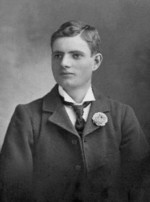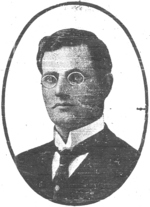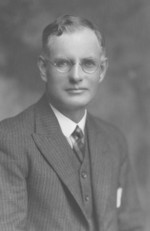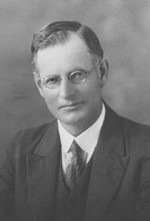John Curtin
| Surname | Curtin |
| Given Name | John |
| Born | 8 Jan 1885 |
| Died | 5 Jul 1945 |
| Country | Australia |
| Category | Government |
| Gender | Male |
Contributor: Morgan Bell
ww2dbaseWhen the caucus of the Australian Labor Party (ALP) elected, with eleven votes to ten, John Curtin as leader of the party as it entered another term as the Opposition in 1935, no one foresaw that within the next decade he would be prime minister of Australia, and once that decade neared its conclusion he would be dead. Even the press gallery of the national parliament was surprised at the ALP's choice. The Labor Party in South Australia had divided into four factions, the Labor Party in New South Wales divided into three. Curtin could not point to natural advantages in his life that made him the best choice, but the decision would have a profound effect on Australia's war effort in the coming Second World War. He came from a poor Irish-Catholic family in rural Victoria. John Joseph Ambrose Curtin was born in cheap, rented wooden housing in the former gold rush town of Creswick in Victoria. His father was a policeman that suffered from severe arthritis. The family went from rented house to rented house for the next few years, on average cheap and nasty semi-permanent accommodation. Curtin's formal education had been as ramshackle and meandering as the family's early life trying to find housing, so Curtin would read by candlelight in bed at night. Curtin's father passed away in the final few years of the nineteenth century, so Curtin left school at fourteen and got a job to support his widowed mother and the rest of the family, doing office work and deliveries of a popular art magazine for fellow resident of Creswick, Norman Lindsay, who later became an artist of some renown in Australia. Curtin moved to Brunswick in Melbourne and got a job at the Titan Manufacturing Company. He continued educating himself by travelling to the Melbourne City Library after work and using the reading rooms. Most likely due to his background, Curtin became interested in socialism. His friendship to another resident of Brunswick and socialist agitator, Frank Anstey, guided his interest towards labour politics in parliament. About this time Curtin became a copyboy for a Melbourne newspaper. With the arrival of the renowned British socialist, Tom Mann, in Australia, Curtin's socialism took another turn. Mann was disillusioned with the idea of a parliamentary route to socialist reform. Curtin helped found the Victorian Socialist Party, whose aim was to campaign away from state Labor politicians who did not promote the socialist cause and promote those who would. Curtin then became secretary of the Timberworkers Union, a position he resigned from, more out of alcoholism than mental strain. His dependence on alcohol got so consuming he was almost committed to a private sanatorium. When Australia joined the mother country's side in the First World War, Curtin entered federal politics by running for the seat of Balaclava in 1914, at the time considered lost to the ALP as the Liberal member was the former Victorian premier that had tried a career in federal politics and was soon to become acting prime minister. Curtin ran one of the best political campaigns Australia saw at that time, and eventually organized the protest against the ALP government of Billy Hughes for the anti-conscription cause. Refusing to attend a medical examination to judge if he was fit for service as a conscript, Curtin was imprisoned for his beliefs. Curtin was rejected by an earlier examination for military service because of his poor eyesight when he had volunteered for the 1st AIF, so his incarceration was based on principle. These were compelling reasons to argue in the ALP caucus in 1935 that Curtin was an unsuitable choice to be voted as Opposition leader.
ww2dbaseIn the role he excelled, bringing together the fractured elements of the federal and various state Labor parties under the umbrella of a united Opposition. Such a force opposing the government's ideas in parliament made Menzies tremble and think twice before making a decision not in Australia's defence interests. Curtin refused to take advantage of the Menzies government's minority in parliament to advance himself as the head of a new Labor government, preferring to wait until the next election to possibly win a mandate from the people. Australian newspapers interpreted this refusal by Curtin to aggressively criticize Menzies in an attempt to topple him, making way for a Labor government, as revealing Curtin's cowardice and irresponsibility. Curtin honestly believed that Menzies was a better wartime prime minister than Curtin himself ever would be. When Menzies almost lost government in the general election of 1940, it prompted calls for a national administration in Canberra similar to the one in Britain, which consisted of elements of the Conservative, Liberal and Labor Parties. Neither Menzies nor Curtin wanted to travel down this road. Curtin's hold on the leadership of the ALP was too tenuous for this option. It was Curtin who suggested to Menzies that he form an advisory war council, consisting of four members of the government and four opposition members, to discuss vital war matters. The advisory war council was formed on 28 October 1940. It met throughout the length of the war to decide Australian strategy and issues of state.
ww2dbaseWhile John Curtin made an unlikely, albeit talented, leader of the Opposition, any Australian with money on this horse to be Prime Minister would have expected to lose. Nonetheless, Curtin was asked to form a government when Arthur Fadden lost his government's majority in parliament on the night of 3 October 1941, through two Independents crossing the house to vote against the government. On 7 October 1941 Curtin served his first day as prime minister. Before this, Curtin had never held a ministry post, and the highest managerial position he had held was as secretary of a small trade union. His recent political career was far from sterling, he was defeated in four attempts to gain a seat in the House of Representatives, and in the election of 1940 he had almost lost a fifth attempt. When offered a safe Labor seat in case he lost his Freemantle seat, he indignantly replied
ww2dbaseCurtin had no more political security than Menzies or Fadden, who preceeded him, also facing opposition in parliament and the party. The Australian public's attitude to defence was very much stuck in the apathetic colonial mentality, relying on Britain to take care of it, when they needed to be self-reliant. In addition to political insecurity, Curtin wrestled with the dark side of his soul: he was an emotional, thoughtful man who was a chronic worrier, not an ideal personality type for the role of wartime prime minister, but he always tried to do the best thing for Australia. This was most evident when news arrived of the disappearance of the HMAS Sydney on 19 November 1941 off the coast of Western Australia. A number of German raiders known to be operating in the Indian Ocean could have accounted for the disappearance. Curtin visited the governor-general, Alexander Hore-Ruthven, to seek advice, as he could not bring himself to announce the loss to the country. The governor-general advised waiting a few days in case some good news arrived, later saying of Curtin "He's terribly sensitive, but he's a man of great courage". Curtin finally announced the loss of the cruiser with all her crew, a sobering naval tragedy, on 30 November. Two days later Curtin had to announce the sinking of HMAS Parramatta, with the loss of 141 of her crew. A week later Japan entered the war. It was an accumulation of unfortunate events in quick succession, like these circumstances, that plunged Curtin into the depths of his black moods throughout the length of the war.
ww2dbaseCurtin's government had inherited unfavourable circumstances from his predecessors: London was preoccupied with the European war; Australia's most proficient, battle-tested divisions were serving in the distant Middle East; and Japan was taking advantage of this situation to gain territories by military conquest in Asia and the Pacific. On 27 December Curtin published the words of a New Year's speech in the Melbourne Herald. His appeal that was aimed at the United States was clear during the war, but the following oft-quoted text is frequently misinterpreted by historians:
ww2dbaseMany historians take that portion of text out of context from the words of the entire article, as well as out of context of the ideas and situation of the time. Some argue that it is a move towards a truly independent Australian foreign policy, free of the mother country and Commonwealth. Others see it as a need, on Australia's part, for a single powerful ally. Whatever Curtin had in mind, when Curchill read the entire text he was angry enough to identify Australians as "bad stock". Not because Australia looks to America, but that it does so free of traditional links to the United Kingdom. Australia and Britain already agreed that the United States should play a primary role in the war in the Pacific, and Churchill and Roosevelt had already agreed that the United States would assume responsibility for Australia. Churchill was concerned that Curtin's statements in the same piece "The Australian government regards the Pacific struggle primarily as one which the United States and Australia must have the fullest say in the direction of the democracies' fighting plan" and "we refuse the dictum that the Pacific struggle must be treated as a subordinate segment of the general conflict" were a direct challenge to the Germany First strategy. Previously Churchill had sought to convey communication from Australia to the United States, so he had greater control over strategic direction of the war. Curtin wanted the messages to go directly, so he could say what he wanted to say, not what Churchill wanted him to say.
ww2dbaseCurtin did not just have to stave off emotional depression brought about by damaging enemy action by the Germans or Japanese against the HMAS Sydney in 1941 or Port Darwin in 1942 respectively, but the Japanese attack on Pearl Harbor on 7 December 1941 opened a diplomatic dispute between Canberra and Whitehall in the persons of Curtin and Churchill that Curtin described as a "cable war". At the time the war against Germany was going poorly from Churchill's perspective, with the continental western democracies sudbued by the Wehrmacht's blitzkrieg, and the Russians appearing to be on the verge of being overwhelmed by a powerful German onslaught in the form of Operation Barbarossa. The Middle East appeared to be under control for now, with Rommel having been fought back by a British counter-offensive by Claude Auchinleck, but that was potentially temporary. A timely offensive by Rommel could exploit the extended British supply line to regain lost ground. If the Soviet Union folded like a house of cards, as Churchill expected, the Wehrmacht could envelop British forces in the Middle East in a pincer manoeuver through the Caucasus and the Balkans. Then the Japanese attacked Pearl Harbor, bringing themselves and the United States into the war. Churchill, upon hearing this news, emphatically exclaimed "So we've won after all!", hoping to direct the huge resources of American industry to the fight against Germany. For Curtin, this was concerning, this meant Japan was able to invade Australia, with relatively minimal defences, with the 2nd AIF in the distant Middle East, and no British fleet forthcoming to Australia's assistance. Curtin requested the return of the Australian divisions in the Middle East to contribute to their nation's defence. Churchill himself ordered the 6th and 7th Divisions to the Far East to fight in the war against Japan. The troops would be returned in Operation Stepsister, where 64,000 Australian troops and their equipment would be transported in 70 ships of varying sizes across the Indian Ocean, the exact destination undetermined. With German raiders and Japanese submarines operating in these waters, it is little wonder that Curtin got little sleep while the troops made their journey between January and April 1942. Churchill wanted the original destination to be Singapore, after Churchill had sent substantial, but inadequate land and naval forces to Singapore, more than he thought wise to group in one place in case the Japanese besieged it. The Commonwealth forces in Malaya, out numbering the Japanese, were still forced to retreat to Singapore Island in the face of Yamashita's advance, which enjoyed air supremacy. The two modern warships, the Prince of Wales and Repulse, which Churchill had sent to Singapore on 2 December 1941 at Curtin's request for more forces for the defence of the island. These ships, which Curtin expected much of to halt the Japanese advance, were sunk by torpedo bombers on 10 December 1941. By January 1942, Chururchill realized that Singapore had little strategic value, but still wanted the besieged fortress to receive additional defenders, which he intended as the original destination of the troops being transported in Operation Stepsister. Fortunately, they did not arrive, as with the Island's drinking water being obtained from the Malay Peninsula and few naval defences, Singapore did not resist the Japanese siege for long, and fell on 15 February 1942. Churchill decided the Australian forces would be better deployed under Wavell's command in Java and Sumatra. Black smoke that billowed forth from fires that engulfed the ruins of the Singapore Island fortress, destroyed by the Japanese army on 15 February 1942, obscured clear vision between both parties in the Anglo-Australian relationship. The imperial partners, Britain and Australia, on opposite sides of the globe were each presented with different threats in their region. Britain faced Germany with a defensive ditch known as the English Channel separating them, while Australia faced Japan with the vastness of the Pacific Ocean and many guarded territories between them. Japan could do little to threaten Britain itself, similarly Germany was only a threat to Australia if the United Kingdom was defeated, so Australia sent three divisions for Britain's use in the war against Germany, which Churchill insisted to return to the Far East for use in the war against Japan. They were about to be deployed under Wavell for the second time, previously they had been under his command when they first arrived in the Middle East, now it was to be in Java in the ABDA area. This prompted a five day cable war between Curtin and Churchill. The Australian defence chiefs advised that in light of the rapid Japanese advance, a destination in South East Asia no longer made sense. The landing Australian divisions might be captured, in which case they could not defend Australia anyway. It would be best to bring them to Australia. On 15 February, Curtin took their advice and cabled Churchill, requesting that the ships still in transit be re-diverted to Australia. It was the right choice, on 16 February Wavell cabled Whitehall to inform them that Java could not be held, so suggested the Australian divisions should be re-diverted to Burma to aid the defence against the Japanese assault on Rangoon. Churchill was predisposed to this idea, if the Japanese took Burma, they could invade India, and would control the Indian Ocean, which would mean Axis domination in the Mederterranean Sea and Indian Ocean, regions which encompassed many British interests. Anthony Eden had also informed Churchill that an attack on the Burma Road would mean that Japan and the United Kingdom were at war. On 17 February, after receiving news of the plans regarding Burma, Curtin cabled Churchill again requesting that the troops be sent directly to Australia. Churchill was convince if he could stall Curtin, he could change his Australian counterpart's mind, so he diverted the troopships north bound for Burma. Roosevelt, at Churchill's request, cabled Curtin, requesting that the divisions be sent to Burma. Churchill had convinced Roosevelt that it was necessary to keep the Burma Road open to supply China, and only the Australian divisions were close enough to do it. Curtin refused to budge, meeting with the cabinet to say that it was now impractical to give "substantial aid to countries outside Australia". The war cabinet agreed to take steps for a full mobilization of resources for the war. After this, Curtin was scheduled to speak at a war loan rally in Martin Place. Within three quarters of an hour of finishing his speech, he was admitted to St Vincent's hospital with what appeared to be gastritis inflamed by nervous tension. While Curtin was in hospital, his ministers stuck to his last orders. Curtin appears to have done the right thing, the Japanese were only forty miles from Rangoon, and the divisions were not tactically loaded, with equipment shipped separately to speed shipping times, so the divisions could not disembark ready to engage the Japanese.
ww2dbaseAfter the Japanese takeover of the Phillippines, in which General Douglas MacArthur had to retreat to Bataan and Corregidor, President Roosevelt ordered the "Lion of Luzon" to proceed immediately to Australia, which would be used as a military base from which the Allies could strike back at the rapidly gained territories of the Greater East Asia Co-Prosperity Sphere. After MacArthur landed in Darwin following a ten hour flight from Mindinao in a B-17, Curtin's government appointed him supreme commander of the South-West Pacific Area. When they first met, Curtin assured MacArthur that he would "see him through until our flags float side by side in Manila". MacArthur said of Curtin "We promptly came to a sense of mutual trust, co-operation and regard". Both men were fighters: Curtin by nature and past; MacArthur by nature and profession. Curtin quickly realized Australia's subordinate role in the alliance with the United States, so frequently acquiesced to MacArthur's decisions, but also realized that as the location of MacArthur's command, Australia would have greater access to United States war materiel than previously.
ww2dbaseThe campaign in New Guinea exposed disparities between both forces that comprised the Australian army at the time: the militia and the AIF. The former consisted of 262,333 troops and could only be deployed within Australia or for the defence of her mandated territories in the nearby islands, while the latter consisted of 171,246 troops that could be employed anywhere in the world. For about a year the Opposition had pointed out these differences to make political headway against Curtin's ALP government. The Minister for the Army, Frank Forde, criticized this viewpoint, saying it was "the foolish clamour of political opportunists, but in November 1942 Curtin himself advocated such a move. At a Special Federal Conference of the ALP he proposed the geographical restrictions on the use of the militia be relaxed to include "such other territories in the South-West Pacific Area as the Governor-General proclaims as being territories associated with the defence of Australia". The suggestion provoked criticism from Curtin's party colleages, it could not have been an easy choice to make for Curtin, in light of his political activism during the First World War. Curtin shepherded his proposal through the ALP organizational machinery, parliament, and the war cabinet, until on 4 January 1943, it was endorsed by a Special Federal Conference of the ALP.
ww2dbaseAfter leading the country through the crisis year of 1942, when the fate of Australia in the Pacific war seemed at its most critical, Curtin faced the Australian general election of 1943. Curtin's ALP government swept back into power, with the largest two-house victory since federation. Even in the glow of an unprecedented victory, both in the war and the election, Curtin was a sick man. The pressures of war took a heavy toll. At 4am on 5 July 1945 he passed away. This news was met with sorrow by his party colleagues and anxiety by the Australian public. How could either face steering the nation's final efforts to navigate the end of the war without Curtin's strengths and abilities that made him a great wartime prime minister? Newspapers in the United States and Australia considered Curtin a war casualty, suggesting the strain of war brought about his demise. MacArthur, not one to aggrandize anyone but himself, said of Curtin
ww2dbaseHis ALP colleages elected wartime treasurer Ben Chifley as successor to Curtin. He would consolidate in the postwar period the victories that Curtin led Australia to in the Second World War.
ww2dbaseSources: D. Day, John Curtin: A Life, National Archives of Australia, N. E. Lee, John Curtin: Saviour of Australia, J. Edwards, Curtin's Gift: Reinterpreting Australia's Greatest Prime Minister, J. Beaumont, Australia's War: 1939-45, D. Day, The Politics of War, P. Thompson, Pacific Fury.
Last Major Revision: Oct 2008
John Curtin Interactive Map
Photographs
 |  |  |  |
John Curtin Timeline
| 8 Jan 1885 | John Curtin was born. |
| 15 Oct 1941 | The new Australian Prime Minister, John Curtin, announced that the Australian garrison in Tobruk, Libya would be withdrawn immediately. British Prime Minister Winston Churchill, in fit of rage, bitterly complained to Beaverbrook: "We are at war with almost every country, including Australia!" |
| 24 Jan 1942 | John Curtin, the Australian Premiere, called for an Australian representative to be appointed to the Imperial War Cabinet, and further proposed the establishment of a Pacific Council for joint consultation between all the Allied countries particularly concerned. |
| 29 Apr 1944 | Australian Prime Minister John Curtin arrived in London, England, United Kingdom for the Imperial Conference. |
| 5 Jul 1945 | John Curtin passed away from heart disease. |
Did you enjoy this article or find this article helpful? If so, please consider supporting us on Patreon. Even $1 per month will go a long way! Thank you. Share this article with your friends: Stay updated with WW2DB: |
Visitor Submitted Comments
23 Aug 2012 03:06:33 PM
Very detailed information - thank you! It was very useful and helpful with my WW2 research!
27 Aug 2012 01:28:41 AM
Really Helped a lot when studying Australia's involvement in the Pacific during WWII
All visitor submitted comments are opinions of those making the submissions and do not reflect views of WW2DB.
» Anzac Conference
- » 1,150 biographies
- » 337 events
- » 43,897 timeline entries
- » 1,241 ships
- » 350 aircraft models
- » 207 vehicle models
- » 372 weapon models
- » 123 historical documents
- » 260 facilities
- » 470 book reviews
- » 28,528 photos
- » 432 maps
Lt. Gen. Lewis B. "Chesty" Puller, at Guadalcanal
Please consider supporting us on Patreon. Even $1 a month will go a long way. Thank you!
Or, please support us by purchasing some WW2DB merchandise at TeeSpring, Thank you!
13 Aug 2009 01:27:56 AM
This is really excellent, I'm using it for a history essay I'm writing on Curtin.
I just wanted to know when it was written so I can acknowledge it properly in my bibliography.